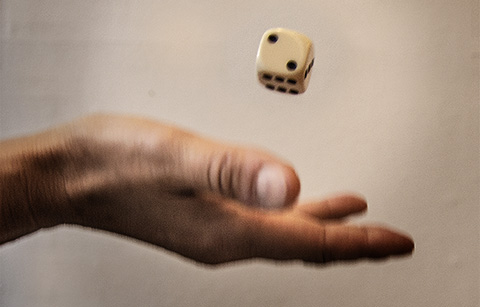Jolij was surprised and happy last week when nearly three hundred students clicked the link to his study on parapsychological phenomena. The students were presented with ten randomly generated numbers and asked to say if the numbers meant anything to them.
What they didn’t know was that five of the numbers had been generated by the software program Qualtrics and the other five by a quantum random number generator.
‘That quantum generator is electrically connected to a diode’, Jolij explains. ‘That means electrons can only travel through it in one direction. But those electrons are also quantum particles, which sometimes engage in what’s known as quantum tunnelling. Basically, they’re going the wrong way on a one-way street. The leads to extremely small variations that can be digitised and converted into random numbers.’
Funny coincidence
Jolij wanted to know whether people saw meaning in the quantum-generated numbers more often than they did the software-generated ones. And believe it or not: they did. The p value of the significance was 0.0013. ‘That means that if you were to repeat this experiment a thousand times, you’d get these same results at least once’, Jolij explains. ‘And that’s a lot.’
The issue with statistics, though, is that if you have enough people participating in a certain experiment you’ll always end up with a significant p value. It could still be a coincidence. ‘But then it’s a really funny coincidence.’
Bayes factor
Jolij re-analysed the results using Bayesian statistics, which measure how likely certain results are based on the available data. ‘The Bayes factor measures how likely a certain hypothesis is to be true over another one. In this case, the hypothesis is whether or not there’s a difference between the software-generated numbers and the quantum-generated numbers. It turns out there is a difference.’
According to Jolij’s calculations, the Bayes factor was 5.86. In other words: the odds that he’s measured an actual effect are almost six times larger than the odds that this was a coincidence. ‘But because other studies have taught us that there’s always a chance for a very small effect, I included that in the calculations as well.’
This second calculation also filtered out extremely large effects. This time, the Bayes factor was 29.84. This mean the odds of the effect being ‘real’ are almost thirty times larger than the odds of coincidence.
Phone number
What happens next? Jolij didn’t have any expectations of the experiment. ‘It’s one of those things where you’re like, it’ll be fun to do, but it probably won’t lead to anything.’ He did register the experiment with the ethical committee, just to cover his bases. ‘This data set does present evidence of a possible difference, but unless we manage to reproduce this more often, which we especially need to do because it’s so unlikely, we can’t really draw any conclusions. The only conclusion we have right now is: this is fun, we should do it more often.’
He acknowledges that the results are bizarre. ‘It’s completely insane that a phenomenon like quantum tunnelling can cause people to see their colleague’s phone number in randomly generated numbers. But that’s what happened here.’
He can’t explain what happened. ‘All we know right now is that it’s just a really interesting effect.’
Jacob Jolij’s experiment is still running. Want to participate? You can!




